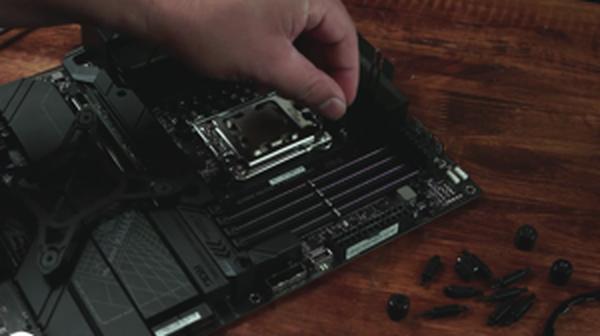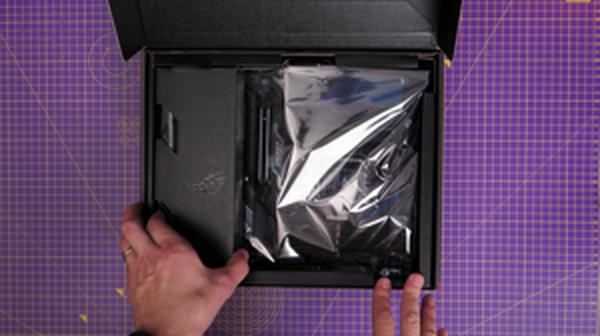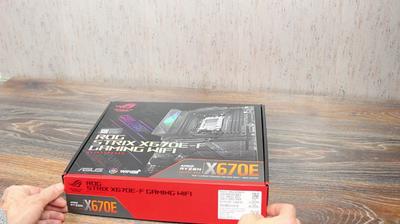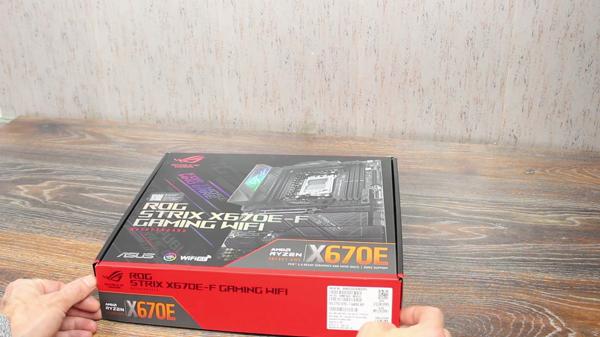
Trying out the ASUS ROG Strix X670E-F Gaming Motherboard (2024)
My thoughts on the ASUS ROG Strix X670E-F Gaming Motherboard: overclocking power, VRM, quality, real-world performance.
Introduction
I've been working with the ASUS ROG Strix X670E-F Gaming motherboard to see how it holds up under stress and for everyday use. The power delivery and overclocking potential are very promising - but it has a high price tag at the same time. More on this below.
Some photos (click to enlarge)




Specs of the ASUS ROG Strix X670E-F Gaming Motherboard
- Release Year
- Brand
- Chipset Type
- Compatible Devices
- Cpu Socket
- Memory Clock Speed
- Memory Storage Capacity
- Model Name
- Platform
- Ram Memory Maximum Size
- Ram Memory Technology
Prices
In-depth Analysis of Power Delivery and Overclocking Potential

When it comes to pushing the limits on a motherboard, power delivery, and overclocking potentials are key areas that I tend to focus on. In my experience with the ASUS ROG Strix X670E-F Gaming, there's a lot to talk about:
Optimized Thermal Design: The inclusion of massive VRM heatsinks, a high-conductivity thermal pad, and an L-shaped heatpipe help in distributing heat and keeping things cool under pressure. Heat is something you don’t want playing around with potential.
Overclocking Technologies: Features like Dynamic OC Switcher and Ryzen Core Flex offer tailored overclocking experiences. This is particularly beneficial for fine-tuning performance based on workload demands.
High-Quality VRM: A sturdy power phase design is crucial for reliability, especially when overclocking, and it seems ASUS didn't cut corners here.
However, it's not without its drawbacks. For instance, the lack of a post-code display or onboard power/reset buttons—which many would expect at this price point—can be seen as a letdown. This is particularly true when you're troubleshooting or fine-tuning an OC profile.
With that out of the way, let's talk about the VRM Heatsink Array that's a central feature for robust power delivery on this board. The heatsinks are beefy and effectively shunt away the heat from the VRMs, keeping temperatures in control, even when overclocking. In the realm of high-end motherboards, this kind of thermal management can often be a deciding factor, and the X670E-F doesn't disappoint.
The use of high-conductivity thermal pads also speaks to the attention to detail that ASUS has put into the board's manufacturing. Better thermal interfacing between components means lowered temperatures and increased stability—a must for any overclocking enthusiast like myself.
Now, let's touch on where the board really shines – its overclocking prowess. The Dynamic OC Switcher is a game-changer, allowing for on-the-fly switching between precision boost for lighter tasks and more aggressive manual overclocks when needed. AMD Precision Boost Overdrive (PBO), coupled with traditional overclocking, provides the flexibility to push all-core frequencies higher than stock, harnessing the full potential of the CPU when needed.
The Core Flex feature is another overclocker's delight, letting you push the boundaries of the base clock and set profiles according to thermal and power thresholds. This granular control allows me to fine-tune my system to the edge of its capabilities while ensuring stability—a sweet spot for any power user.
The cherry on top is the memory overclocking support. With extended support for AMD EXPO profiles, high-speed DDR5 memory kits can be pushed even beyond their rated speeds, which is fantastic for those, like me, who aim for that extra edge in performance.
In the pursuit of maximum performance, cooling and power are king, and while ASUS could improve on the luxuries we expect at this price point, the ROG Strix X670E-F certainly holds its ground where it counts the most – in delivering stable, overclocked performance for enthusiasts willing to push their AMD Ryzen 7000 series CPUs to the limit.
Connectivity and Networking Capabilities

When scouting for a motherboard that could handle my networking and connectivity demands, the ASUS ROG Strix X670E-F Gaming was a strong contender. Here are the key aspects that stood out:
Wi-Fi 6E: The onboard Wi-Fi 6E is a game-changer, promising higher bandwidth and less congestion. Having access to the 6 GHz band makes a noticeable difference in crowded areas, although it's worth noting that Wi-Fi 6E access can vary based on local regulations.
Intel 2.5G Ethernet: This feature is sweet for hardcore gamers or anyone involved in heavy-duty streaming or content creation. It offers a stable and fast wired connection, which is essential for when I can't afford lag or interruption.
ASUS LANGuard: An underrated feature that provides an extra layer of protection for your Ethernet port. It gives me peace of mind knowing my connection is safeguarded against electrical surges.
However, it's not all peaches and cream. I've noticed some inconsistencies with the Intel LAN adapter, causing network instability for several users, including myself. This type of glitch is particularly annoying, considering the premium we're paying for the board. Another letdown is that, despite the high cost, there's no on-board power or reset button, nor any debug LED code display—features I'd expect at this price point.
On the flip side, the board doesn't skimp on the latest specs for data transfer:
PCIe 5.0: This is perfect for both the top x16 extension slot and two of the M.2 slots, ready for next-gen graphics cards and super-fast NVMe SSDs.
USB 3.2 Gen 2x2: The front-panel connector is a nice touch for high-speed external storage or peripherals.
Here's a quick rundown of what stood out:
Pros:
Cutting-edge Wi-Fi 6E technology.
Fast and reliable Intel 2.5G Ethernet.
PCIe 5.0 slots provide future-proofing for storage and graphics.
Superior protection with ASUS LANGuard.
Cons:
Intel LAN adapter can be hit or miss with stability.
Lack of integrated troubleshooting features (e.g., Q-Code LED display).
No onboard power or reset buttons, which can be a hassle.
Despite some hiccups, the ASUS ROG Strix X670E-F Gaming has delivered a generally solid experience. It's equipped to cater to the high-speed demands of the latest online games and bandwidth-intensive tasks. And while it's not perfect, the pros outweigh the cons—making it a worthwhile investment for a user looking for top-notch connectivity in a stylish package. The board's future-proofing assures me that I won't need an upgrade anytime soon, but I'm keeping my fingers crossed for ASUS to step up their game with consistent driver updates and more refined onboard features in their future iterations.
Aesthetic and Build Quality Considerations

When it comes to the aesthetic and build quality of the ASUS ROG Strix X670E-F Gaming Motherboard, there are several standout features that catch my eye:
Futuristic design elements and iridescent ROG logo enhance the visual appeal.
Monochrome finish and customizable Aura lighting offer a vibrant yet subtle look.
However, while I appreciate the high-quality materials and attention to detail, such as the massive VRM heatsinks and integrated aluminum I/O cover, I can't ignore a few setbacks. For starters, the ROG logo, while visually pleasing, feels like a missed opportunity—it lacks a direct backlight, which could have taken the overall aesthetic to the next level.
Regarding build quality, I’m generally impressed. The board feels robust and well-engineered. The thick VRM heatsinks aid in cooling and are evidence of ASUS's attention to managing the high performance of the Ryzen 7000 series CPUs. Also, the use of high-conductivity thermal pads reflects the company's commitment to reliability and longevity.
On the downside, some users have reported issues with coil whine, which can be a deal-breaker for those who prize a quiet operating environment. While I haven't experienced this personally, it's a concern I've taken note of, particularly when considering the premium price point.
The board's appeal is undoubtedly heightened by its stealthy black PCB and dark metallic heatsinks, which blend seamlessly into most build themes. Customization enthusiasts will find the RGB lighting on the I/O shroud a nice touch, allowing the board to either stand out or maintain a more reserved presence within their setup.
In terms of practical aesthetics, features like the SafeSlot for supporting heavy graphics cards and Q-release for easy component swaps add functional elegance to the motherboard. ASUS has carefully balanced form with function, ensuring that this motherboard doesn’t just look good, but is designed for usability.
I also appreciate the onboard WiFi 6E and Intel 2.5 Gb Ethernet for their part in not only boosting performance but maintaining the sleek look of my setup by reducing cable clutter. That being said, reports of network instability have come up, though they are possibly attributable to early adoption hiccups that future firmware updates could mend.
Overall, the ROG Strix X670E has an aesthetic that resonates with my preference for a clean, minimalist build that does not compromise on flair, paired with build quality that suggests it can stand the test of time. As a part of my larger rig, it checks most of the boxes for what I look for in a motherboard, despite the few areas where it could improve.
Performance and Stability in Real-World Use

In the realm of PC building, the ASUS ROG Strix X670E-F Gaming Motherboard has been a significant talking point, especially in the context of harnessing the prowess of the latest AMD Ryzen 7000 series CPUs. After putting this motherboard through its paces, it's clear to see that it delivers solid performance, and it handles heavy loads admirably - something gamers and power users will certainly appreciate.
Here's a quick list summarizing my takeaways:
Stability: I've thrown various tasks at it, from gaming to video rendering, and the system remains stable without any hiccups.
Performance: With the default BIOS settings, my Ryzen 7950X goes above and beyond, making everyday tasks and gaming a breeze.
Thermals: Those massive heatsinks aren’t just for show. Even under load, temperatures stay within a reasonable range.
User Experience: Getting everything set up was straightforward, although diving into the finer details of BIOS configuration requires a learning curve.
The overclocking capabilities, paired with the Dynamic OC Switcher, provide a substantial performance edge, allowing the CPU to flex its muscles more effectively when required. However, it's worth noting that some users have reported coil whine issues, which thankfully wasn't something I encountered.
On the topic of RAM performance, out-of-the-box support for DDR5 is a game-changer, offering ample headroom for future upgrades. However, the current RAM speed limitations are more reflective of the CPU and platform maturity than the motherboard itself.
WiFi 6E presents a considerable advancement in wireless connectivity, although it's essential to remember that such technology's full potential hinges on the supporting infrastructure and spectrum availability, which can still be somewhat constrained depending on your location.
There are a couple of points that left me wanting, though. The lack of a built-in Q-code display is a noticeable omission for troubleshooting, which at this price point should arguably be a standard feature. The ASUS Armory Crate software has room for improvement too – it can be somewhat unintuitive, and the lack of timely driver updates from ASUS can be frustrating.
In conclusion, while the ASUS ROG Strix X670E-F Gaming Motherboard is not without its flaws, the board's performance, stability, and vast feature set present a palpable value proposition that can't be overlooked. The high price is a tough pill to swallow, yet the technological investment offers a degree of future-proofing in this rapidly advancing arena. Although it's a significant outlay, for those committed to pushing their system to the limit, the Strix X670E-F stands as a potent platform that's hard to ignore.
Comments (0)
Share